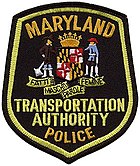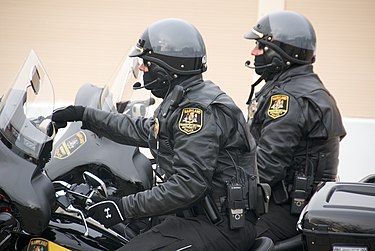
The California Highway Patrol (CHP) is a state law enforcement agency of the U.S. state of California. The CHP has primary patrol jurisdiction over all California highways and roads and streets outside city limits, and can exercise law enforcement powers anywhere within the state. California Highway Patrol can assist local and county agencies and can patrol major city streets along with local and county law enforcement, state and interstate highways and are primary law enforcement in rural parts of the state.

Transit police are specialized police agencies employed either by a common carrier or a municipality, county, district, or state. Transit law enforcement services may also be provided by a specialized unit within a larger local law enforcement agency. Their mandate is to prevent and investigate crimes committed against the carrier or by or against passengers or other customers of the carrier, or those committed on the carrier's property.
Interstate 895 (I-895) is an Interstate Highway in the U.S. state of Maryland. Known as the Harbor Tunnel Thruway, the highway runs 14.87 miles (23.93 km) between one junction with I-95 in Elkridge and another interchange with I-95 on the east side of Baltimore. I-895 is a toll road that crosses the Patapsco River estuary via the Baltimore Harbor Tunnel, connecting U.S. Route 1, I-695, and the Baltimore–Washington Parkway in the southwestern suburbs of Baltimore with US 40 on the east side of Baltimore. In conjunction with a pair of spurs, unsigned I-895A and I-895B, I-895 provides access to the tunnel from I-97 and Maryland Route 2 in Glen Burnie. The highway is designed for through traffic by having partial interchanges that require vehicles from almost all starting points to pass through the tunnel and the tunnel toll plaza, where a $4 toll is charged to passenger vehicles, before exiting the facility.

Water police, also called harbor patrols, port police, marine/maritime police, nautical patrols, bay constables,river police, or maritime law enforcement are police officers, usually a department of a larger police organization, who patrol in water craft. Their patrol areas may be coastal sea waters, rivers, estuaries, harbors, lakes, canals or a combination of these.
Interstate 695 (I-695) is a 51.46-mile-long (82.82 km) full beltway Interstate Highway extending around Baltimore, Maryland, United States. I-695 is officially designated the McKeldin Beltway, but is colloquially referred to as either the Baltimore Beltway or 695. The route is an auxiliary route of I-95, intersecting that route southwest of Baltimore near Arbutus and northeast of the city near White Marsh. It also intersects other major roads radiating from the Baltimore area, including I-97 near Glen Burnie, the Baltimore–Washington Parkway near Linthicum, I-70 near Woodlawn, I-795 near Pikesville, and I-83 in the Timonium area. The 19.37-mile (31.17 km) portion of the Baltimore Beltway between I-95 northeast of Baltimore and I-97 south of Baltimore is officially Maryland Route 695 (MD 695), and is not part of the Interstate Highway System, but is signed as I-695. This section of the route includes the Francis Scott Key Bridge that crosses over the Patapsco River. The bridge and its approaches are maintained by the Maryland Transportation Authority (MDTA) while the remainder of the Baltimore Beltway is maintained by the Maryland State Highway Administration (MDSHA).
The Maryland Transportation Authority (MDTA) is an independent state agency responsible for financing, constructing, operating, and maintaining eight transportation facilities, currently consisting of two toll roads, two tunnels, and four bridges in Maryland. It also provides the Maryland Department of Transportation with financing for other revenue producing transportation projects.

The Francis Scott Key Bridge, also known originally as the Outer Harbor Crossing or simply as the Key Bridge or Beltway Bridge, is a steel arch-shaped continuous through truss bridge spanning the lower Patapsco River and outer Baltimore Harbor / Port in Baltimore, Maryland, United States. The main span of 1,200 feet (366 m) is the third longest span of any continuous truss in the world. It is also the longest bridge in the Baltimore metropolitan area.

The Washington State Patrol (WSP) is the state police agency for the U.S. state of Washington. Organized as the Washington State Highway Patrol in 1921, it was renamed and reconstituted in 1933. The agency is charged with the protection of the Governor of Washington and the grounds of the Washington State Capitol; security aboard the vessels and terminals of the Washington State Ferries; law enforcement on interstate and state highways in Washington; and providing specialized support to local law enforcement including laboratory forensic services, mobile field forces during periods of civil unrest or disaster, and tactical teams. The State Fire Marshal's Office, responsible for operation of the Washington State Fire Training Academy and for certain aspects of civil defense mobilization, is a component office of the Washington State Patrol, and the State Patrol is the managing agency of the Washington Fusion Center, which coordinates anti-terrorist and anti-organized crime activities within Washington.
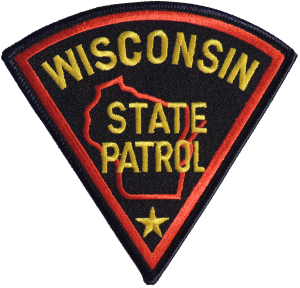
The Wisconsin State Patrol is the highway patrol for the state of Wisconsin and is a division of the Wisconsin Department of Transportation. The Wisconsin State Patrol enforces traffic and criminal laws, oversees the motor carrier safety and weight facilities (SWEFs), inspects and regulates motor carriers, school buses and ambulances, and assists local law enforcement agencies with traffic safety, civil disturbances and disasters.

The Maryland State Police (MSP), officially the Maryland Department of State Police (MDSP), is the official state police force of the U.S. state of Maryland. The Maryland State Police is headquartered at 1201 Reisterstown Road in the Pikesville CDP in unincorporated Baltimore County.
Interstate 95 (I-95) is an Interstate Highway running along the East Coast of the United States from Miami, Florida north to the Canadian border in Houlton, Maine. In Maryland, the route is a major highway that runs 109.01 miles (175.43 km) diagonally from southwest to northeast, entering from the District of Columbia and Virginia at the Woodrow Wilson Bridge, to Maryland's border with Delaware. It is also the longest Interstate Highway within Maryland. The route is one of the most traveled Interstate Highways in the state, especially between Baltimore and Washington, D.C., despite alternate routes along the corridor, such as the Baltimore–Washington Parkway, U.S. Route 1, and US 29. Portions of the highway, including the Fort McHenry Tunnel and the Millard E. Tydings Memorial Bridge, are tolled.

The Port Authority of New York and New Jersey Police Department, or Port Authority Police Department (PAPD), is a law enforcement agency in New York and New Jersey, the duties of which are to protect and to enforce state and city laws at all the facilities, owned or operated by the Port Authority of New York and New Jersey (PANYNJ), the bi-state agency running airports, seaports, and many bridges and tunnels within the Port of New York and New Jersey. Additionally, the PAPD is responsible for other PANYNJ properties including three bus terminals, the World Trade Center in Lower Manhattan, and the PATH train system. The PAPD is the largest transit-related police force in the United States.

The Baltimore Harbor Tunnel is a pair of two-lane road tunnels carrying Interstate 895—the Harbor Tunnel Thruway—under the Patapsco River southeast of downtown Baltimore, Maryland. The tunnel was designed by Peter Johnson.
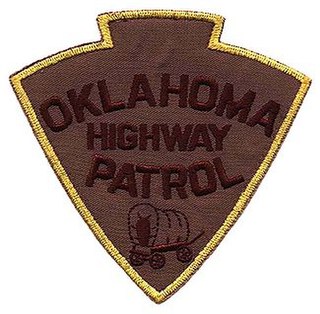
The Oklahoma Highway Patrol (OHP) is a major state law enforcement agency of the government of Oklahoma. A division of the Oklahoma Department of Public Safety, the OHP has traffic enforcement jurisdiction throughout the state. OHP was legislatively created on July 1, 1937, due to the growing problem of motor vehicle collisions, the expansion of highway systems, and the increase in criminal activities.
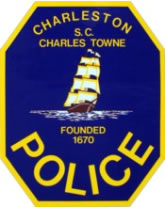
The City of Charleston Police Department (CPD) is the official police force of Charleston, South Carolina. It is South Carolina's largest municipal agency, besides the South Carolina Highway Patrol, in terms of manpower, with 458 sworn officers, 137 civilian personnel and numerous reserve officers and non-sworn volunteers. In July, 2011, the department was re-accredited through 2014 with the Accreditation with Excellence Award by the Commission on Accreditation for Law Enforcement Agencies (CALEA). Replacing the former "Flagship Award," the Accreditation with Excellence Award is the highest single-period accreditation award available. The department also received the Meritorious Accreditation Award in 2011, representing at least 15 continuous years of CALEA accreditation.

The New Jersey Transit Police Department (NJTPD) is a transit police agency of the New Jersey Transit Corporation in the state of New Jersey. As provided by NJS Title 27:25-15.1, New Jersey Transit Police Officers have "general authority, without limitation, to exercise police powers and duties, as provided by law for police officers and law enforcement officers, in all criminal and traffic matters at all times throughout the State and, in addition, to enforce such rules and regulations as the NJ Transit Corporation shall adopt and deem appropriate." The primary focus of NJTPD is providing police services to the numerous bus depots, rail and light rail stations throughout New Jersey. The New Jersey Transit Police Department is the only transit police agency in the United States with statewide authority and jurisdiction.

The Maryland Natural Resources Police (NRP) is the law enforcement arm of the Maryland Department of Natural Resources (DNR), tasked with enforcing laws on the state's public lands and waterways, protecting fish and wildlife, and leading search and rescue efforts. The Natural Resources Police is also the state's maritime homeland security agency.

The New York City Police Department (NYPD) is structured into numerous bureaus and units. As a whole, the NYPD is headed by the Police Commissioner, a civilian administrator appointed by the Mayor, with the senior sworn uniformed officer of the service titled "Chief of Department". The Police Commissioner appoints a number of Deputy and Assistant Commissioners. The department is divided into twenty bureaus, six of which are enforcement bureaus. Each enforcement bureau is further sub-divided into sections, divisions, and units, and into patrol boroughs, precincts, and detective squads. Each Bureau is commanded by a Bureau Chief. There are also a number of specialized units that are not part of any of the Bureaus and report to the Chief of the department.

In the United States, the state police is a police body unique to each U.S. state, having statewide authority to conduct law enforcement activities and criminal investigations. In general, state police officers, known as state troopers, perform functions that do not fall within the jurisdiction of the county sheriff, such as enforcing traffic laws on state highways and interstate expressways, overseeing the security of the state capitol complex, protecting the governor, training new officers for local police forces too small to operate an academy and providing technological and scientific services. They support local police and help to coordinate multi-jurisdictional task force activity in serious or complicated cases in those states that grant full police powers statewide.
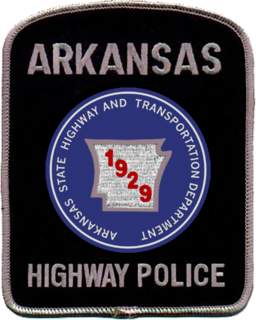
The Arkansas Highway Police is a highway police unit of the state of Arkansas. It primarily enforce rules and regulations of the Arkansas Department of Transportation. Its other responsibilities are Motor Carrier Enforcement, Traffic Control, Hazardous Material enforcement, and drug interdiction. It is the second-largest state law enforcement agency in Arkansas after the Arkansas State Police. It was founded in 1929 and is the oldest law enforcement agency in Arkansas.
